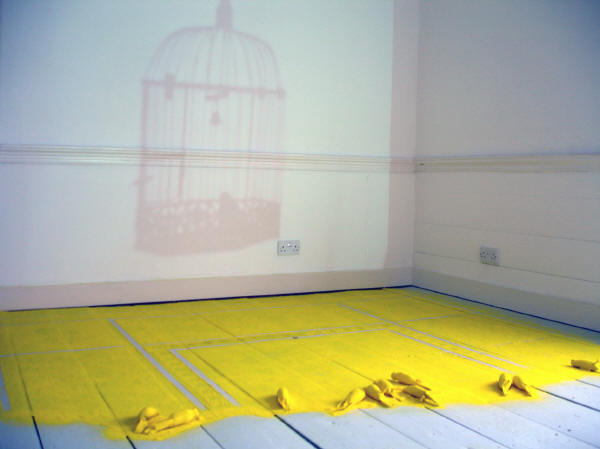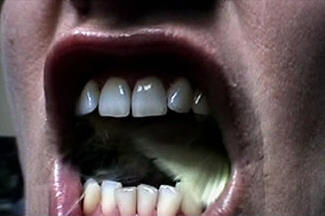 |
||
| home | features | exhibitions | interviews | profiles | webprojects | gazetteer | links | archive | forum | ||
|
|
||
Canaries in the AtticLucy Willow The Salt Gallery, Hayle
On first entering the room, the faint scent of powder-paint emanating from the pure yellow pigment of Lucy Willow’s 'carpet', evokes memories from childhood. Stencilled with a floral design, the powder covers half of the dove-grey floor boarding, then raggedly tapers off. Littering its fringes are the stiff desiccated bodies of canaries. A video monitor in one corner of the room shows a close-up of a mouth literally spitting out feathers. Rolled around the tongue, they abruptly disappear to slowly re-emerge, an effect made more surreal in that it is produced by the playback of an inverse action. The moist tongue sticks to dry fluff, a fleshy rhythmic mastication like a heartbeat, in an otherwise petrified space.
A projection on the far wall shows the shadow of a caged bird, flitting from floor to perch and back again. As the cage rocks, it shifts in and out of focus according to the light levels in the room. Outside the night deepens and the image acquires distinction, while a recording of birdsong trills melodiously in the background. Suspended by the window is a metal cage with a bird corpse on its floor, not yellow this time, but greying. It completes the symmetry of the installation and perhaps overstates the symbolism of caged freedom, but this tarnished cage also evokes a kind of morning-after despair hanging over night’s threatening hues. The piece, says Willow in her statement, suggests 'a state of mind that follows loss.' Amongst the dualisms put into play by the work are darkness and light, madness and sanity, the cellar and the attic. The canary can be used as a metaphor to describe 'highly sensitive persons who absorb what is going on in their environment to the point of destruction.'
Willow has been influenced by Charlotte Perkins Gilman’s nineteenth century semi-autobiographical story, The Yellow Wallpaper. In it, a young mother suffering from post-natal depression is confined by her husband and forbidden access to her child or to the therapeutic comfort of writing. Isolated in an attic (a nursery at the top of the house) she becomes transfixed by patterns in the wallpaper, believing she can see a woman trapped inside its ornamental forms:
I never saw a worse paper in my life. The Yellow Wallpaper, Charlotte Perkins Gilman The domestic space of the Salt Gallery’s front room is perfect for the late Victorian associations of mad-woman-in-attic, from Gilman to Bertha Rochester. Indeed, the room seems cramped if more than four people are in it at once, given that the work covers half of the floor space. There is a mild sense of intrusion when walking into such a space, accustomed as we can be to larger galleries, which can accommodate installation as an immersive spectacle or a dramatic staging of object, sound or video. Seated by the window, my eyes are drawn back to the feather-chewing mouth on the monitor. I think of Runa Islam’s film; Be the first to See What You See As you See It (2005), in which a graceful woman methodically destroys a display of fine china. It is the tone of protracted absorption that is similar. This piece is not about irrational thought or action in the sense of play, but has a mood of sadness, of compulsive meditation. Here is the repeated pattern that loops in our mind, the compulsion to chew over the indigestible or incomprehensible. The artist places us physically within a waking dream. Like Gilman’s Yellow Wallpaper it eschews the domestic space as a restful sanctuary for a more disjointed experience: one without comforting resolution.
Megs Wakefield 14th May 2007 |
||


